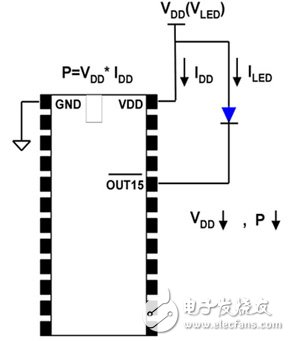In recent years, due to the shortage of energy, the issue of energy saving has been paid more and more attention. In order to meet the needs of low power consumption, long life, no pollution, and short startup time, current lighting equipment has adopted a large number of high-brightness light-emitting diodes (LEDs) to replace traditional Illumination light source. The LED driver provides constant current control, so that the LED maintains a stable brightness and saturated color spectrum. In order to comply with industrial and energy-saving standards for display screen design, the LED driver must have automatic power-saving features. It is urgent to reduce the power loss of LED driver LEDs are used in information screens, traffic signs, and some image screen applications. Only part of the time and area will be lit by the driver (Figure 1). The black area of ​​the car speed or speed limit display device is the LED off section; red and white are The LED is lit. If it is in the area where the LED is off, the LED driver still maintains normal operation, but the power consumption of the entire screen will increase when the LED is not lit for a long time, and the life of the driver will be shortened, which cannot achieve power saving. effect. In order to achieve the power-saving function, when the vehicle passes a certain road section, the LED speed measuring device will automatically light up and inform the driver of the speed. After a period of time, if no car passes, the speed measuring device will automatically turn off, the LED will not consume current, and the driver will automatically enter Sleep mode, such as an LED driver with power saving mode, consumes less than 0.1 milliwatts after entering sleep mode, which can greatly reduce the average power consumption of the entire screen. Reducing the heat dissipation power of the driver can also improve the overall power efficiency. Methods include reducing the power supply current (IDD), power supply voltage (VDD), LED voltage (VLED), and output terminal withstand voltage (VDS). The heat dissipation power of the driver can be obtained by calculating the following formula: Figure 1 Display device for vehicle speed or speed limit PSD = PDN + PDM PSD: The cooling power of all the drivers on the system PDN: The cooling power of the operating drivers on the system. Among them, PDN = (IDD & TImes; VDD) + IOUT & TImes; Duty & TImes; VDSx16) & TImes; N, and N is the operating Total number of drivers; PDM: the cooling power of the drivers that are not operating on the system, where PDM = IDD × VDD × M, and M is the total number of drivers that are not operating. In addition, the driver power loss can be obtained by the following formula: PDRVLOSS = PALLDRV-PUSEDRV PDRVLOSS: unused driver power loss PALLDRV: power consumption of all drivers PUSEDRV: power consumption of the lighting driver However, the following methods It can achieve the effect of reducing power loss, but relatively has to pay the cost or affect the display quality of the entire screen. Among them, the industry has developed two methods: mandatory sleep mode (Sleep Mode) and zero energy-saving power-saving mode (0-Power Mode) LED driver, which can meet the above power saving requirements without any other negative effects . The traditional LED driver power saving method has many defects The traditional LED driver power saving method includes low operating voltage and R-EXT pin floating connection, and its operation is as follows: ? Low operating voltage Operate the driver on the whole screen below the allowable minimum rated voltage, such as 3 volts. According to the relationship P = I × V, it can be seen that when the supply voltage is reduced, the power consumption is also reduced to achieve the purpose of saving power. However, this method is limited by the application conditions. When VDD and VLED are shared, if a blue or green LED is used, a relatively high voltage is required (Figure 2). Figure 2 Power saving mode when VDD and VLED are shared ? R-EXT pin floating After the R-EXT pin is floating (Figure 3), the current regulator inside the driver will be turned off, which will save about 50% of the power. However, this method will also increase the cost and complexity of the system design, and some ICs Abnormality may occur after floating. Figure 3 Power saving mode when the R-EXT pin is floating Window Optical Lenses,Optical Lenses,Window Optical Lens,Calcium Fluoride Glass Window Danyang Horse Optical Co., Ltd , https://www.dyhorseoptical.com

